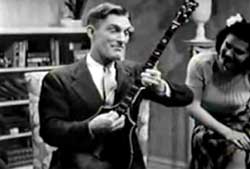 Eddie Peabody was possibly the world's most famous banjo player from the 1920s & 30s, & remained honored as a master of the instrument throughout his life, long after his sales power had diminished. He never retired & in 1970 had a stroke & died on stage, so it can truly be said the banjo was his whole life.
Eddie Peabody was possibly the world's most famous banjo player from the 1920s & 30s, & remained honored as a master of the instrument throughout his life, long after his sales power had diminished. He never retired & in 1970 had a stroke & died on stage, so it can truly be said the banjo was his whole life.
He promoted himself as "King of the Banjo" & many times it has been said he was the best banjoist who ever lived. In reality he performed odd novelties & hoary cliche numbers & did nothing to raise the banjo above the level of minstrelsy & vaudeville.
He was entertaining but if that was as good as banjo music could get, it wouldn't be all that valuable an instrument, whereas the authentically great players like Earl Scruggs proved transcendence was possible.
For the first half of the mere two-minute panoram soundie Strum Fun (1942), Eddie plays "Mighty Lak a Rose" on a mandolin. For the second half he swaps instruments for a traditional rattly-tinkly plectrum banjo on which he performs "Some of the These Days." He has a third instrument nearby, a guitar, but isn't shown playing that.
He's no great showman; he's just sitting & playing -- playing very well of course. To give it a bit of visual liveliness he's shown in a living room setting with friends, three nice looking gals & a piano player, Don Pedro. We're supposed to believe lovely ladies just swoon over a grandfatherly-nerdy banjo picker.
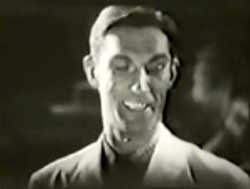 Hula Heaven (1937) is a one-reel musical short in the Paramount Headliners series, starring world-famed banjoist Eddie Peabody. Eddie's placed in a Hawaiian setting surrounded by Hula girls, who sing & dance & play string instruments.
Hula Heaven (1937) is a one-reel musical short in the Paramount Headliners series, starring world-famed banjoist Eddie Peabody. Eddie's placed in a Hawaiian setting surrounded by Hula girls, who sing & dance & play string instruments.
As the film begins Eddie is banging away on his plectrum banjo on the staged beach. A troupe of hula girls sing in Hawaiian as soon as Eddie's first number is finished, & do some swaying on their knees. Eddie watches the girls & a Hawaiian swing band in Polynesian native get-ups. They're very talented but not credited.
When the native band finishes their number Eddie says, "Goll darn nice of you chief to throw this party for me. Now I know where swing rhythm was really born. Now I gotta brand new number I think you folks are going to enjoy. Remember, girls, the one Bing Crosby taught us coming over on the boat."
He plays "Blue Hawaii" on a rather amazing looking harp-guitar as the trio of mainlander gals harmonize very prettily, to stock footage of island scenes.
When that number is finished, a South American tucan is shown in the trees, making the sound of an Australian laughing-jackass. This item of Hawaiian fantasy-wildlife induces Eddie to play his "Listen to the Mockingbird" novelty number on violin, from which instrument he manages to coax bird trills. Musically speaking it's ridiculous, but it was one of his famous campy routines.
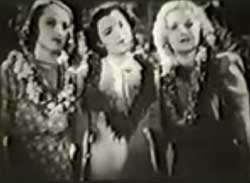 He then plays "Rendezvous with the Dream" on the violin, but plucks & strums the instrument like a mandolin. It's again musically moronic but would delight the kiddies. He then plays "Rendezvous with the Dream" on the violin, but plucks & strums the instrument like a mandolin. It's again musically moronic but would delight the kiddies.
The unnamed Hawaiian band then plays an Hawaiian hula standard so the hula troupe can dance, & Eddie joins the number with a large mandolin.
Lastly, picking up his plectrum banjo, he plays "I'm an Old Cowhand" with the Hawaiian band. One of the girls was playing along quietly on a Spanish guitar, until Eddie puts down the banjo & reaches around the girl from behind to play the guitar while she continues to hold it.
He does this again with the next girl who holds an odd mandolin-like instrument. He does this to four lovely gals apparently as a display of how he can play any stringed guitar-like instrument, but there's nothing particularly excellent about any of it.
He concludes the film back at his banjo being as lively as he can manage, while hula girls sway a little faster than is normal for them. As coda, Eddie joins the dancers.
A cute film overall, but as usual it's hard to see why Peabody was such a big deal. He's ultra-kitschy & does nothing that could be said to improve the reputation of the banjo. And the failure to credit the Hawaiian band & hula troupe is offensive.
Although sundry references insist Hula Heaven was directed by Leslie M. Rousch, the credits with the film itself state it was produced & directed by Herbert Moulton.
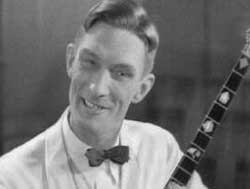 In the self-named Eddie Peabody (1938) filmed by British Pathe, Eddie strolls center stage to stand by the piano, at which an uncredited woman is seated as his accompanyist.
In the self-named Eddie Peabody (1938) filmed by British Pathe, Eddie strolls center stage to stand by the piano, at which an uncredited woman is seated as his accompanyist.
He has a violin to start with, & addresses the audience, noting that he's been asked to do several things in only three minutes.
On the violin he does his campy novelty bit "Listen to the Mockingbird." It's pretty dull & ordinary at first, but then he starts playing with the strings in such a way as to get bird twitters out of it while the piano holds the melody. Camp fun for the kiddies mainly.
With a screen-wipe he's now seated near the piano with his banjo, giving a quicky-lesson on how to play it. "Isn't that simple? Almost anyone can do it." He then plays "When I Grow to Old."
The stunt here is he plays in such a manner as to make it sound like two banjos, one keeping time on tremulo, the other a melodic line.
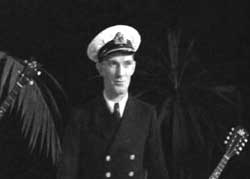 The Famous American Artist Eddie Peobody & His Beachcombers (1938), again from British Pathe, opens with Eddie explaining the all-new "electrophone" that has transformed the Beachcombers into an electric string band.
The Famous American Artist Eddie Peobody & His Beachcombers (1938), again from British Pathe, opens with Eddie explaining the all-new "electrophone" that has transformed the Beachcombers into an electric string band.
He gives an example of what each instrument sounds like "electrified," first the banjo, then the little tenor mandolin, Hawaiian steel guitar, & the Spanish guitar.
He doesn't explain "electrophone" well but it was a clumsy precursor to the type of guitar pick-up that can be inserted into an accoustic.
This primitive pick-up requires that the instruments be mounted in-place on a table, & the musicians have to be able to play motionless instruments, making it very unnatural except for the steel guitar.
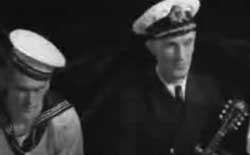 He then invites the Beachcombers onto the stage, all dressed like sailor lads. He then invites the Beachcombers onto the stage, all dressed like sailor lads.
Together they perform "Song of the Island" on a stage tricked out minimally to look like an island setting with full moon on the backdrop.
The song should be retitled "Lumber through the Number" as it plods along miserably with most of the instruments immobilized by the dreadful "electrophone."
Jump-cut to some stock photography of Polynesian islands, struggling to give it all a Hawaiian swing sound. Back to the stage Eddie & the Beachcombers up the temp for "Hilo March," jump-cutting to some Hawaiian hula girl stock footage.
Eddie's instrument on the first number is the mandolin, then he swaps to the steel guitar for the second number. This terrible musical short pretty much confirms he should stick to the banjo, which he renders least dull.
copyright © by Paghat the Ratgirl
|
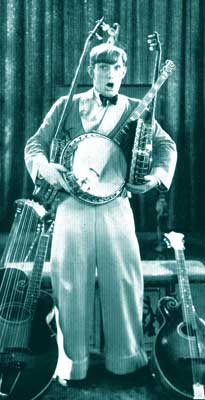


 He then plays "Rendezvous with the Dream" on the violin, but plucks & strums the instrument like a mandolin. It's again musically moronic but would delight the kiddies.
He then plays "Rendezvous with the Dream" on the violin, but plucks & strums the instrument like a mandolin. It's again musically moronic but would delight the kiddies.

 He then invites the Beachcombers onto the stage, all dressed like sailor lads.
He then invites the Beachcombers onto the stage, all dressed like sailor lads.